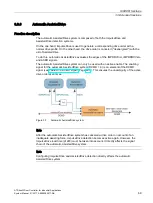
SIDOOR functions
3.3 Extended functions
ATD4xxW Door Controller for Industrial Applications
72
System Manual, 01/2017, A5E38080677-AB
3.3.8.1
Obstruction detection process
The obstruction detection is based on two processes that are independent of the direction:
force obstruction detection and stop obstruction detection.
The following definitions are based on the speeds and are thus independent of the direction.
The obstruction detection systems assume that the system is actively being moved (drive
order).
●
Force obstruction detection
The current speed is > 90 mm/s, and drops by more than 90 mm/s in comparison to the
maximum speed reached during the current movement.
If the system then moves for the set duration (p3854 and/or p3871) at the upper force
limitation, a force obstruction is detected in the current drive direction.
●
Stop obstruction detection
If the current speed for the configured time (p3853 or p3870) is less than 10 mm/s, a stop
obstruction corresponding to the current direction of travel is detected.
As of V1.09:
If the door has been in the CLOSE position for at least 3 seconds and it is then subjected to
extreme force with the pending command CLOSE DOOR, the travel in the CLOSE direction
will detect no obstruction.
3.3.8.2
Overcome obstruction
The overcome obstruction system can be used to overcome a blocking obstruction by
repeated pushing. The system remains active as long as the initial drive order is not actively
changed.
Example
1.
The drive order "close" is present.
2.
The system closes.
3.
An obstruction is detected before reaching the "Closed" end stop.
4.
The second of four retries is made.
5.
The drive order "close" is overwritten by any other drive order.
6.
The retry system is immediately exited.
7.
The system responds according to the new drive order.
















































